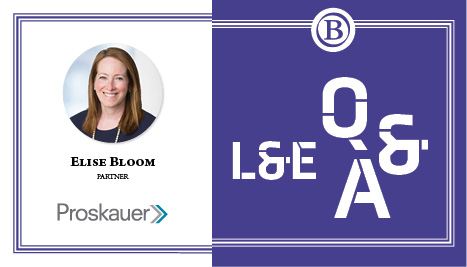
Elise Bloom, Proskauer’s former labor and employment practice co-chair and class and collective actions co-head, speaks with Benchmark Litigation Labor & Employment Editor Brittany Sharoff about the challenges of litigating during the pandemic, employment litigation trends and her experience winning a precedentsetting case. As a litigator featured on the inaugural Top 20 Lawyers in Labor & Employment, Bloom also shares her expertise and advice for Human Resources departments and upcoming lawyers in the practice area.
___________________________________________________________________________________________________
This has certainly been a challenging year for everyone. The labor and employment industry has worked tirelessly to assist employers throughout this time. What has been the most difficult aspect of litigating during the pandemic?
Conducting depositions virtually and participating in appellate arguments were most difficult to do during the pandemic. In terms of depositions, it is difficult to establish a cadence and it is very hard to view exhibits on the screen and conduct an effective examination. With appellate arguments, if you are arguing before a panel, you cannot see all the judges, so it is very difficult to read the room.
Are there any employment trends you expect to see more of over the next year?
I am expecting more cases involving accommodation requests stemming from COVID situations. I also think that there is going to continue to be an emphasis on diversity issues and scope of inclusion —specifically ensuring that there is sufficient coverage of all different groups and issues.
What is one piece of advice you would give to organizations as they grapple with bringing employees back to the office?
There is no one size fits all in this area because the science is constantly evolving and the guidance on how to keep employees safe changes all the time. You also should not shy away from changing mid-stream on a plan. In many aspects, there is no right or wrong answer, and that answer can change, so it is important to involve your Human Resources staff and your in-house legal department, as well as your business leaders to encompass as many perspectives as possible.
Your recent case for Michael Bloomberg cleared up who can be considered liable as an employer. This decision will likely have a significant impact, especially on business owners. What are some key takeaways that business owners should keep in mind going forward? What was most exciting about litigating that case?
The most exciting aspect of the case was establishing the law. Having the chance to advocate on a topic that was not decided was really great. For many years, everyone had just assumed the answer without carefully studying the statute and the case law, and it was challenging and invigorating to be able to actually take this on and create the argument for what the standard should be. It is even more exciting to be successful. This is an important decision for business owners because it holds that simply because someone is a high-level executive or a business owner they are not going to be personally liable for the conduct of others, which they did not participate in.
You are on the inaugural list of Top 20 Lawyers in Labor & Employment this year. What advice would you give to new lawyers practicing in labor and employment who wish to achieve similar success?
First, always do your homework and be prepared. Do not be afraid to take a contrary position if you have all the facts and studied the law. New ideas are important. Learn from your mistakes because we all make them. Also learn from your adversaries. Just because they are on the other side of the “v” does not mean that you cannot learn from them.
Second, love what you do and always try to be positive. Hard work pays off! Remember, at the end of the day it is the client’s case. Give them your best judgment, but never forget that it is their case – not yours – and they will have to live with the outcome, whereas you will move on to your next case.
Lastly, take time to enjoy life and listen to the world around you. What you learn from your real-life experiences is important in making you a good lawyer.
You are a renowned litigator in the practice area and I’m sure many look up to you. Who do you look up to? Who are some of your biggest influences?
The people who have had the biggest influence on my life are the women in my family. I have been fortunate to be surrounded and have always been surrounded by strong, independent women. From growing up with my mother and my aunt and first cousin, to now being surrounded by my sister-in-law, my nieces and my two step-daughters, I have learned so many life lessons from them that have helped to shape my career and my values as a person. They all lead by example in different ways but are never wavering in their support of me, which has enabled me to pursue my dreams as a lawyer.


